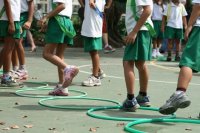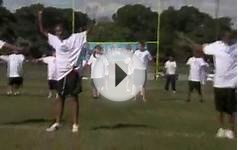 Princeton, N.J. – In a time of heightened worries that U.S. public schools do not give enough emphasis to math and English, a new poll released today finds that many parents are concerned about inadequate levels of physical education. NPR/Robert Wood Johnson Foundation/Harvard School of Public Health (HSPH) polled 1, 368 parents of public school children in grades K-12 on a range of issues around education and health in the their child’s school. One in four parents (25%) said their child’s school gives too little emphasis to physical education, compared with one in seven who say the same thing about reading and writing (14%) or math (15%).
Princeton, N.J. – In a time of heightened worries that U.S. public schools do not give enough emphasis to math and English, a new poll released today finds that many parents are concerned about inadequate levels of physical education. NPR/Robert Wood Johnson Foundation/Harvard School of Public Health (HSPH) polled 1, 368 parents of public school children in grades K-12 on a range of issues around education and health in the their child’s school. One in four parents (25%) said their child’s school gives too little emphasis to physical education, compared with one in seven who say the same thing about reading and writing (14%) or math (15%).
In addition, about three in 10 parents (28%) give a low grade (C, D or F) to their child’s school on providing enough time for physical education, while almost seven in 10 parents (68%) report that their child’s school does not provide daily physical education classes, a recommendation included in CDC guidelines for schools. Just under two in 10 parents (18%) give a low grade to their child’s school on providing quality facilities for physical exercise, like playgrounds, ball fields, or basketball courts.
“In a period with a significant public debate about the content of educational reform, it is significant that many parents feel that more physical education is needed in the schools, ” said Robert Blendon, Richard L. Menschel Professor of Health Policy and Political Analysis at HSPH.
These concerns expressed by some parents are shared by experts in childhood health.
“Experts recommend that high school and middle school students get 225 minutes of physical education per week during the school year, but in fact many don’t get that much, ” said Dwayne Proctor, who directs the childhood obesity team at the Robert Wood Johnson Foundation (RWJF). “Parents should let their state boards of education and their local school districts know that they want more PE for their kids, and encourage state and local policymakers to provide the necessary resources for full implementation.”
Currently, less than half of youths meet the U.S. Department of Health and Human Services’ Physical Activity Guidelines for Americans recommendation of at least 60 minutes of daily moderate-to-vigorous physical activity. This increases youths’ health risks and can jeopardize their well-being throughout their lives. Physical activity is also critical to children’s cognitive development and academic success.








